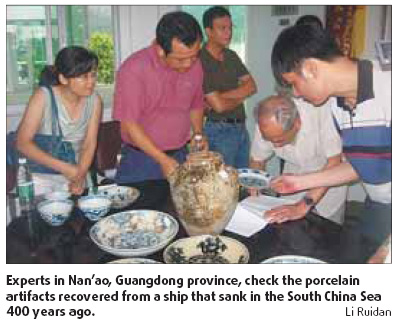
|
CHINA> National
 |
|
Searching for a trade route in salty waters
By Lin Shujuan (China Daily)
Updated: 2009-09-26 09:29 Marine Silk Road. Did such a route really exist? Well, we will get a lot of evidence in the next three months to prove it did.
 Marine archaeologists hope to recover up to 10,000 pieces of porcelain from a ship that sank in the South China Sea during the Ming Dynasty (1368-1644) and provide further evidence that China plied trade through the seas, too.
Work to haul the treasure out of the ship, now called Nan'ao No 1, will start on Saturday. Earlier named Nanhai No 2, the ship was discovered by two fishing boats near Nan'ao Island, Guangdong province, in May 2007. Work to recover the treasure that went down with the ship more than 400 hundred years ago began early this year, said Long Jiayou, director of the Institute of Archaeology of Guangdong. Divers have recovered more than 300 pieces of porcelain during the past few months while clearing the seabed around the vessel, Long said. That means altogether about 500 pieces have been recovered, for fishermen had taken nearly 200 pieces earlier that police have since seized. Most of the porcelain pieces are blue and white, and were made during the Ming Dynasty in the eastern part of Guangdong or Fujian province, Long said. Two cannons, too, have been found on the vessel, suggesting the sailors were prepared to take on pirates, who were rampant when the "Marine Silk Road" thrived, according to Cui Yong, executive leader of the ship's underwater recovery mission. "The water where the ship lies is shallow enough to allow sunlight to reach the seabed during the day, making it easier for divers to work," Cui said. Nanhai No 1, one of the oldest and largest medieval vessels sailing the "Marine Silk Road", was found off the coast of Yangjiang in Guangdong 22 years ago. Its discovery led to the establishment of the Underwater Archeology Research Center of China (UARCC) and the country's first underwater archeology team. The ship serves as proof that a "Marine Silk Road" did exist. Artifacts, documents and sunken ships that can prove the existence of the sea trade route are rare, said Huang Zongwei, a professor at Sun Yat-sen University in Guangzhou, capital of Gungdong. The UARCC had to lift Nanhai No 1 out of water in its entirety in December 2007 because the sea in which it had sunk was too dark for divers to see and recover the artifacts. The ship today sits in a museum in Guangdong. It was when UARCC was busy preparing to lift Nanhai No 1 that divers found the second vessel, and hence, its previous name, Nanhai No 2, Cui said. "Nanhai (which literally means South China Sea) is a huge expanse of water, and giving a sunken ship that name would not point to its exact location," Cui said. At least 2,000 ships are sleeping on the bed of the South China Sea and more and more are likely to be awakened by human intervention in the near future. That's why experts have decided to name a sunken vessel according to the site it is found. "Therefore, Nanhai No 2 is now Nan'ao No 1," Cui said. UARCC tried to recover the treasure buried in Nan'ao No 1 soon after it was found but it had to suspend the effort after 40 days because salvaging Nanhai No 1 was "more important". "We couldn't handle two major projects at the same time," said Cui, who has been actively involved throughout the operation to the salvage of Nanhai No 1. "Moreover, we had to wait for the State Administration of Cultural Heritage's approval." |